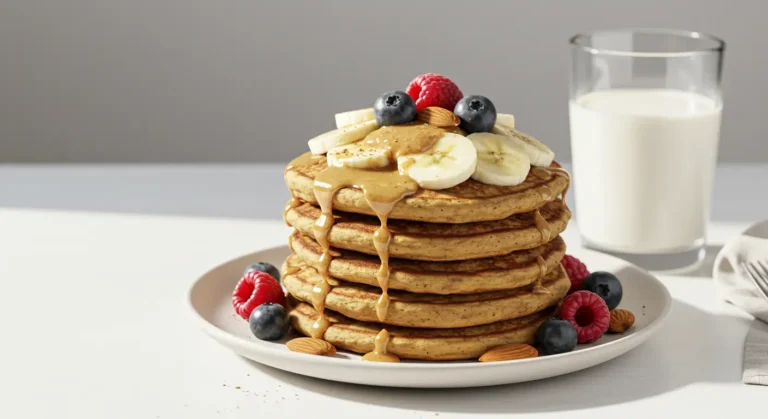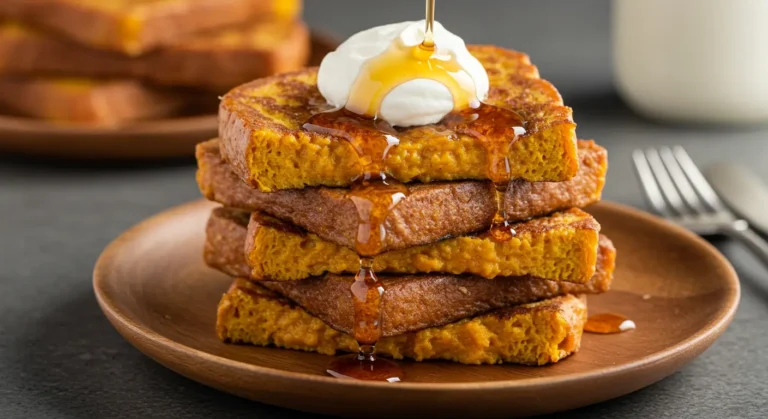Baked Scrambled Eggs: Easy Breakfast in 20 Minutes
Have you ever struggled with getting your scrambled eggs just right while juggling other morning tasks? Many home cooks find themselves facing the challenge of preparing a quick, nutritious breakfast without sacrificing quality or flavor. Baked scrambled eggs offer a brilliant solution to this common culinary dilemma. This hands-off approach transforms the traditional stovetop scramble into an effortless dish that cooks to perfection while you attend to other morning responsibilities. The gentle, even heat of the oven creates remarkably tender and fluffy baked scrambled eggs that maintain their moisture and delicate texture.
Table of Contents
Ingredients List
For this baked scrambled eggs recipe, you’ll need:
- 8 large eggs (preferably organic or free-range for richer flavor)
- 1/4 cup whole milk (substitute with half-and-half for creamier results or plant-based milk for a dairy-free option)
- 2 tablespoons butter, melted (or olive oil for a different flavor profile)
- 1/2 teaspoon salt (sea salt or kosher salt works best)
- 1/4 teaspoon freshly ground black pepper
- 1/4 cup shredded cheese of choice (cheddar, gruyere, or goat cheese add wonderful depth)
- 2 tablespoons fresh chives or green onions, finely chopped
- Optional add-ins: diced bell peppers, spinach, mushrooms, or cooked bacon bits (1/4 cup total)
The beauty of baked scrambled eggs lies in their versatility—you can easily customize the ingredients based on your preferences or what’s available in your refrigerator.
Timing
- Preparation time: 5 minutes
- Cooking time: 15minutes
- Total time: 20 minutes
Step-by-Step Instructions
Step 1: Prepare Your Baking Dish
Preheat your oven to 350°F (175°C). Take a 9×9-inch baking dish and coat it thoroughly with cooking spray or butter to prevent the eggs from sticking. This crucial first step ensures your baked scrambled eggs will release easily once cooked.
Step 2: Whisk the Eggs
In a medium-sized bowl, crack your eggs and whisk them vigorously until the whites and yolks are completely blended. The more air you incorporate during this step, the fluffier your baked scrambled eggs will become. Consider using a fork or whisk and beat for about 30-45 seconds until slightly frothy.
Step 3: Add the Liquid and Seasonings
Pour in the milk and melted butter, then add salt and pepper. Continue whisking until all ingredients are thoroughly combined. The milk adds moisture while the butter enriches your baked scrambled eggs with a velvety texture and enhanced flavor.
Step 4: Mix in Add-ins
Now’s the time to fold in your cheese and any optional ingredients you’ve chosen. Distribute them evenly throughout the egg mixture using a spatula. For best results with vegetables, consider sautéing them briefly beforehand to remove excess moisture that could make your baked scrambled eggs watery.
Step 5: Transfer to Baking Dish
Pour the egg mixture into your prepared baking dish, ensuring an even distribution. Give the dish a gentle tap on the counter to release any large air bubbles that may have formed during the whisking process.
Step 6: Bake to Perfection
Place the dish in the preheated oven and bake for 15-18 minutes. You’ll know your baked scrambled eggs are done when the edges are set but the center still has a slight jiggle. Be careful not to overbake, as the residual heat will continue cooking the eggs after removal from the oven.
Step 7: Rest and Garnish
Allow the baked scrambled eggs to rest for about 2 minutes before serving. This brief resting period allows the eggs to finish cooking gently and set to the perfect consistency. Sprinkle with fresh chives or green onions just before serving to add a pop of color and fresh flavor.
Nutritional Information
For one serving of baked scrambled eggs (approximately 1/4 of the recipe):
- Calories: 220
- Protein: 15g
- Total Fat: 17g
- Saturated Fat: 7g
- Cholesterol: 385mg
- Carbohydrates: 2g
- Fiber: 0g
- Sugar: 1g
- Sodium: 420mg
- Calcium: 120mg
- Iron: 1.5mg
- Vitamin D: 45 IU
- Vitamin A: 540 IU
Healthier Alternatives for the Recipe
Transform your baked scrambled eggs into a healthier version with these modifications:
- Egg whites only: Replace half the whole eggs with egg whites to reduce cholesterol and fat while maintaining high protein content.
- Plant-based milk: Swap traditional dairy milk for unsweetened almond milk or oat milk to reduce calories and add plant-based nutrients.
- Vegetable boost: Increase the vegetable-to-egg ratio by adding spinach, kale, bell peppers, tomatoes, or mushrooms for extra fiber, vitamins, and minerals with minimal calorie addition.
- Herb seasoning: Rely more heavily on fresh herbs and spices rather than salt to reduce sodium content while enhancing flavor.
- Nutritional yeast: Use nutritional yeast instead of cheese for a dairy-free option that adds a cheese-like flavor along with B vitamins.
- Greek yogurt addition: Add a tablespoon of Greek yogurt to the mixture for extra creaminess and protein boost without excessive calories.
Serving Suggestions
Elevate your baked scrambled eggs experience with these ideas:
- Breakfast bowls: Serve over a base of quinoa or roasted sweet potatoes with sliced avocado for a hearty breakfast bowl.
- Wrap it up: Use the baked scrambled eggs as a filling for whole-grain tortillas with a touch of salsa and fresh greens for an on-the-go breakfast wrap.
- Toast topper: Spoon the baked scrambled eggs over artisanal sourdough toast drizzled with olive oil and a sprinkle of red pepper flakes.
- Breakfast sandwich: Build a gourmet sandwich using the baked scrambled eggs between English muffin halves with a slice of tomato and fresh arugula.
- Protein plate: Pair with roasted asparagus and smoked salmon for a low-carb, protein-rich breakfast.
- Family-style brunch: Serve directly in the baking dish alongside a basket of fresh pastries and a colorful fruit salad for weekend gatherings.
Common Mistakes to Avoid
Master this baked scrambled eggs recipe by avoiding these pitfalls:
- Overmixing the eggs: Beating eggs too vigorously after adding other ingredients can make them dense rather than fluffy. Fold add-ins gently to maintain air bubbles.
- Incorrect oven temperature: Using an oven that’s too hot causes the eggs to puff dramatically and then collapse, resulting in a rubbery texture. Stick to moderate heat for even cooking.
- Overbaking: Removing the eggs at just the right moment is crucial. They should appear slightly underdone in the center as they’ll continue cooking from residual heat.
- Forgetting to grease the dish: Even with non-stick bakeware, eggs require proper greasing to prevent sticking and ensure easy serving.
- Using cold ingredients: Cold eggs and milk straight from the refrigerator can lead to uneven cooking. Allow ingredients to reach room temperature for about 15 minutes before mixing.
- Skipping the rest period: Cutting into the baked scrambled eggs immediately after removal from the oven doesn’t allow them to set properly, potentially resulting in a runny center.
Storing Tips for the Recipe
Preserve the freshness of your baked scrambled eggs with these strategies:
- Refrigeration: Store leftover baked scrambled eggs in an airtight container for up to 2 days. The texture may change slightly but the flavor will remain delicious.
- Reheating: Warm refrigerated portions in the microwave at 50% power in 30-second intervals to prevent overcooking. Add a small splash of milk if the eggs seem dry.
- Freezing portions: While not ideal, you can freeze individual portions in freezer-safe containers for up to 1 month. Thaw overnight in the refrigerator before reheating.
- Meal prep: Prepare the egg mixture the night before and refrigerate in a sealed container. In the morning, give it a quick stir before pouring into your baking dish to save precious time.
- Make-ahead add-ins: Chop vegetables and cook any meat additions in advance, storing them separately to quickly assemble your baked scrambled eggs when ready to cook.
- Garnish fresh: Always add delicate herbs like chives or parsley after reheating, not before storage, to maintain their bright flavor and color.
Conclusion
Baked scrambled eggs revolutionize breakfast preparation with a hands-off approach that delivers consistently fluffy, delicious results. This time-saving method allows for endless customization while maintaining the perfect texture that stovetop scrambling often misses. The gentle, even heat of the oven ensures foolproof results every time. Try this baked scrambled eggs recipe today and share your experience in the comments section below! We’d love to hear about your creative variations and how this method has transformed your morning routine.
FAQs
Can I prepare baked scrambled eggs the night before? While it’s best to bake the eggs fresh, you can prepare all ingredients and even mix the egg base the night before. Store it covered in the refrigerator, give it a quick whisk in the morning, and then bake for a streamlined breakfast prep.
Why are my baked scrambled eggs watery? Excess moisture is usually the culprit. Ensure you’re pre-cooking vegetables with high water content, using room-temperature ingredients, and not overbaking, which can cause separation.
Are baked scrambled eggs keto-friendly? Yes, this recipe is naturally keto-compatible. Simply omit any starchy add-ins and use heavy cream instead of milk to further reduce carbohydrates while increasing healthy fats.
How can I make these baked scrambled eggs dairy-free? Substitute the milk with unsweetened almond, coconut, or oat milk, use dairy-free butter or olive oil, and either skip the cheese or use a plant-based cheese alternative for completely dairy-free baked scrambled eggs.
Your Feedback Matters
There are no reviews yet. Be the first one to write one.








One Comment
Comments are closed.